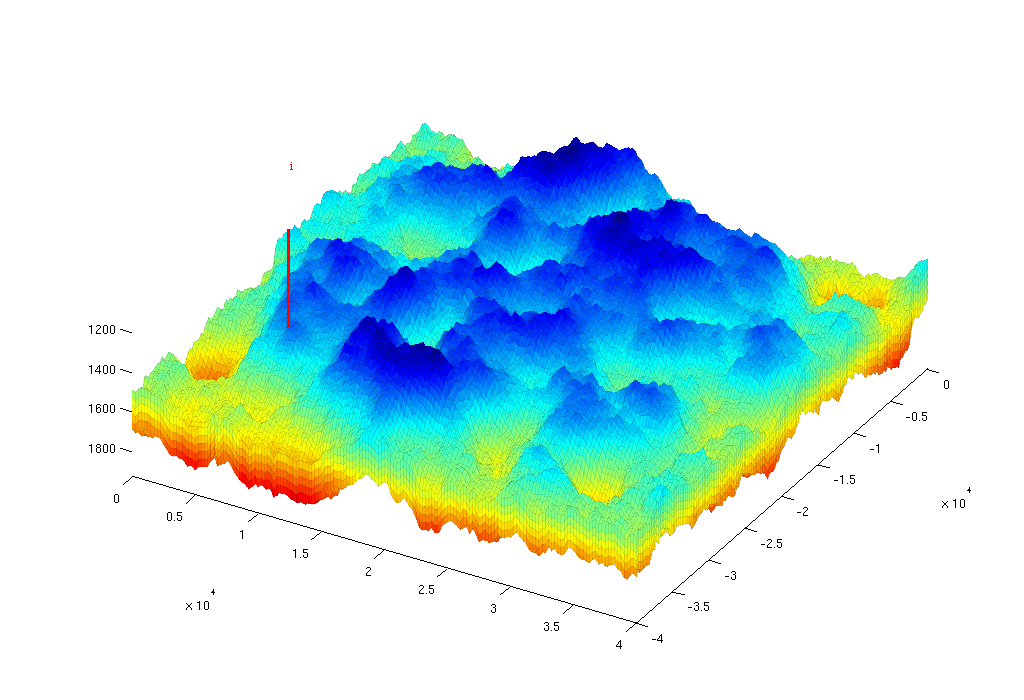In this example we consider a synthetic sloping aquifier created in the IGEMS-CO2 project. The dataset in this example is available for download on this page.
We demonstrate the use of C-accelerated MATLAB, using the functions
- processgrid (replaces processGRDECL)
- mcomputegeometry (replaces computeGeometry)
see the release notes of MRST 2011a for details.
Contents
Video of simulation
Construct stratigraphic and petrophysical model
addpath(fullfile(ROOTDIR,'mex','libgeometry')); % Read data grdecl = readGRDECL(fullfile(ROOTDIR, 'data', 'igems', ... 'IGEMS.GRDECL')); % Map from left-hand to right-hand coordinate system and process grid lines = reshape(grdecl.COORD,6,[]); lines([2 5],:) = -lines([2 5],:); grdecl.COORD = lines(:); clear lines G = processgrid(grdecl); toc % Compute geometry, adding tags needed by topSurfaceGrid G = mcomputeGeometry(G); toc G.cells.faces = [G.cells.faces, repmat((1:6).', [G.cells.num, 1])]; rock = grdecl2Rock(grdecl); rock.perm = convertFrom(rock.perm, milli*darcy); clear grdecl % Top-surface grid disp(' -> Constructing top-surface grid'); [Gt, G] = topSurfaceGrid(G); rock2D = averageRock(rock, Gt);
Set time and fluid parameters
T = 750*year(); stopInject = 150*year(); dT = 1*year(); dTplot = 2*dT; % Make fluid structures, using data that are resonable at p = 300 bar fluidVE = initVEFluid(Gt, 'mu' , [0.056641 0.30860] .* centi*poise, ... 'rho', [686.54 975.86] .* kilogram/meter^3, ... 'sr', 0.2, 'sw', 0.1, 'kwm', [0.2142 0.85]); gravity on
Set well and boundary conditions
We use one well placed down the flank of the model, perforated in the bottom layer. Injection rate is 2.8e4 m^3/day of supercritical CO2. Hydrostatic boundary conditions are specified on all outer boundaries.
% Set well in 3D model wellIx = [G.cartDims(1:2)/5, G.cartDims([3 3])]; rate = 2.8e4*meter^3/day; W = verticalWell([], G, rock, wellIx(1), wellIx(2), ... wellIx(3):wellIx(4), 'Type', 'rate', 'Val', rate, ... 'Radius', 0.1, 'comp_i', [1,0], 'name', 'I'); % Well in 2D model wellIxVE = find(Gt.columns.cells == W(1).cells(1)); wellIxVE = find(wellIxVE - Gt.cells.columnPos >= 0, 1, 'last' ); WVE = addWell([], Gt, rock2D, wellIxVE, ... 'Type', 'rate','Val',rate,'Radius',0.1); % BC in 2D model i = any(Gt.faces.neighbors==0, 2); % find all outer faces I = i(Gt.cells.faces(:,1)); % vector of all faces of all cells, true if outer j = false(6,1); % mask, cells can at most have 6 faces, j(1:4)=true; % extract east, west, north, south J = j(Gt.cells.faces(:,2)); % vector of faces per cell, true if E,W,N,S bcIxVE = Gt.cells.faces(I & J, 1); bcVE = addBC([], bcIxVE, 'pressure', ... Gt.faces.z(bcIxVE)*fluidVE.rho(2)*norm(gravity)); bcVE = rmfield(bcVE,'sat'); bcVE.h = zeros(size(bcVE.face)); % for 2D/vertical average, we need to change defintion of the wells for i=1:numel(WVE) WVE(i).compi=NaN; WVE(i).h = Gt.cells.H(WVE(i).cells); end
Create figure and plot height and well
scrsz = get(0,'ScreenSize'); figVE = figure('Position',[scrsz(3)-1024 scrsz(4)-700 1024 700]); set(0,'CurrentFigure',figVE); plotCellData(G,G.cells.centroids(:,3),'EdgeColor','k','EdgeAlpha',0.05); view([30 60]), axis tight; plotWell(G, W, 'height', 1000, 'color', 'r'); drawnow

Prepare simulations
Compute inner products and instantiate solution structure
SVE = computeMimeticIPVE(Gt, rock2D, 'Innerproduct','ip_simple'); toc preComp = initTransportVE(Gt, rock2D); sol = initResSol(Gt, 0); sol.wellSol = initWellSol(W, 300*barsa()); sol.h = zeros(Gt.cells.num, 1); sol.max_h = sol.h;
Prepare plotting
We will make a composite plot that consists of several parts:
- a 3D plot of the plume
- a pie chart of trapped versus free volume
- a plane view of the plume from above
- two cross-sections in the x/y directions through the well
The code for the plotting is given here, and is also given in the full tutorial runIGEMS.m in the VE module.
Main loop
Run the simulation using a sequential splitting with pressure and transport computed in separate steps. The transport solver is formulated with the height of the CO2 plume as the primary unknown and the relative height (or saturation) must therefore be reconstructed.
t = 0; while t% Advance solution: compute pressure and then transport sol = solveIncompFlowVE(sol, Gt, SVE, rock, fluidVE, ... 'bc', bcVE, 'wells', WVE); sol = explicitTransportVE(sol, Gt, dT, rock, fluidVE, ... 'bc', bcVE, 'wells', WVE, 'preComp', preComp, 'intVert', false); % Reconstruct 'saturation' defined as s=h/H, where h is the height of % the CO2 plume and H is the total height of the formation sol.s = height2Sat(sol, Gt, fluidVE); assert( max(sol.s(:,1))<1+eps && min(sol.s(:,1))>-eps ); t = t + dT; % Check if we are to stop injecting if t>= stopInject WVE = []; bcVE = []; end % Compute trapped and free volumes of CO2 freeVol = ... sum(sol.h.*rock2D.poro.*Gt.cells.volumes)*(1-fluidVE.sw); trappedVol = ... sum((sol.max_h-sol.h).*rock2D.poro.*Gt.cells.volumes)*fluidVE.sr; totVol = trappedVol + freeVol; % Plotting (...) see the full tutorial runIGEMS.m in the VE module for details. end
